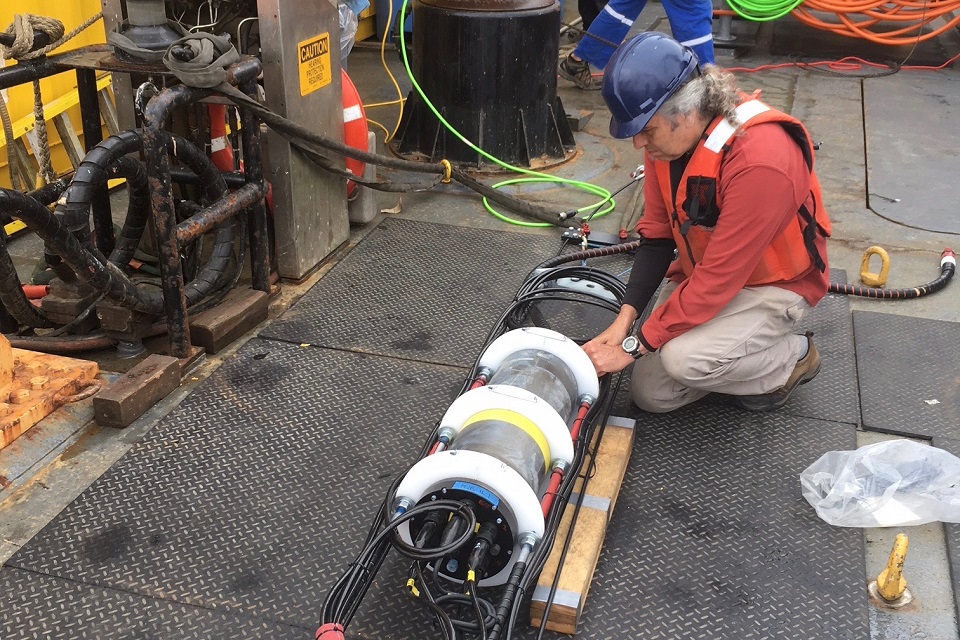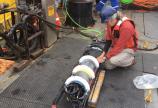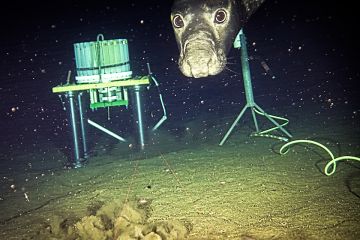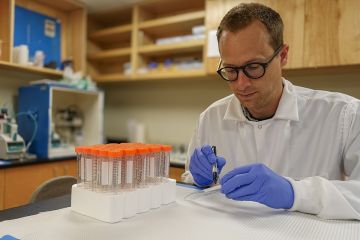Deep space meets deep sea in summer expedition

Ocean Networks Canada (ONC) is installing specialized equipment at its deepest site in the northeast Pacific Ocean to assess the location’s suitability for observing one of the universe’s most essential and difficult-to-study ingredients—neutrinos.
An initiative of the University of Victoria, ONC is deploying the equipment as part of Expedition 2018: Wiring the Abyss, its annual offshore expedition to install and improve cabled observatory infrastructure.
Neutrinos are one of the universe’s most abundant subatomic particles, produced by nuclear reactions from solar fusion, radioactive decay and exploding stars.
Increased knowledge about neutrinos could help answer some of the fundamental questions in astrophysics—such as those posed about the Big Bang and supernovae—and provide insight into the origin, evolution and fate of the universe.
Unlike charged particles and photons, neutrinos lack an electrical charge and can travel across the universe and through normal matter—including the centre of the Earth and human bodies—at nearly the speed of light without interference. This also makes cosmic neutrinos difficult to detect and study without large and very sensitive instruments.
ONC’s two specialized instrument arrays were installed during the first leg of the expedition in late June and will continue commissioning during the expedition’s second visit to the Cascadia Basin site in late July. The collection of detailed measurements over two years will assess the deep-sea site, approximately 200 km southeast of Vancouver Island, for future use.
“A potential full-scale neutrino observatory at Cascadia Basin would benefit particle physics, astrophysics, ocean science and marine biology by offering reliable long-term detection capabilities,” says Benoit Pirenne, ONC’s executive director of user engagement.
The equipment being used to detect neutrinos is also sensitive to bioluminescence, providing scientists with data to study trends in this emission of light by marine animals—used to camouflage, attract, defend, warn, communicate, mimic and illuminate.
ONC’s 2018 expedition includes the installation of new instruments, sensors and cameras at its Endeavour site 300 km off Vancouver Island. The expansion will double the amount of instrumentation and improve the ability of scientists to continuously monitor and study the area’s hydrothermal vent systems and ridge-axis tectonic processes.
Hydrothermal vents at Endeavour are part of Canada’s first marine protected area, established in 2003. The vents host a biologically diverse and productive ecosystem that is home to globally unique and distinct native animal species. ONC has continuously monitored the Endeavour hot vents since 2009.
This year’s expedition will also install the last set of earthquake early warning sensors on ONC’s offshore observatory along the Cascadia subduction zone. ONC and Natural Resources Canada have been simultaneously installing land-based seismic and GPS sensors on Vancouver Island. Once completed, ONC’s comprehensive earthquake early warning system will be tested and delivered to Emergency Management BC by March 2019. The BC government has invested $5 million to help develop the existing system.
Science enthusiasts, technology geeks and keen educators are invited to live dive July 23 to Aug. 3 with ONC during the expedition. Real-time digital camera feeds will feature underwater robots maintaining and expanding the observatory offshore Vancouver Island, while scientists and engineers on board the Ocean Exploration Trust’s vessel E/V Nautilus provide commentary. Follow #ONCabyss for updates and live dive alerts.
About Ocean Networks Canada:
Ocean Networks Canada (ONC), an initiative of the University of Victoria, monitors the west and east coasts of Canada and the Arctic to continuously deliver data in real-time for scientific research that helps communities, governments and industry make informed decisions about our future. Using cabled observatories, remote control systems and interactive sensors, and big data management, ONC enables evidence-based decision-making on ocean management, marine safety and environmental protection. ONC also works in collaboration with educators, students, communities and Indigenous peoples on ocean monitoring initiatives along BC’s coast and in the Arctic.
A press kit containing high-resolution photos is available on Dropbox.
-- 30 --
Photos
Media contacts
Greig Bethel (Ocean Networks Canada media relations) at 250-216-7510 (cell) or gbethel@uvic.ca
Denise Helm (University Communications + Marketing) at 250-721-7656 or dhelm@uvic.ca
Click here for the backgrounder.In this story
Keywords: research, physics, earthquake, oceans, ONC, marine, expedition, neutrino, Cascadia, observatory, science, bioluminescence
People: Benoit Pirenne





